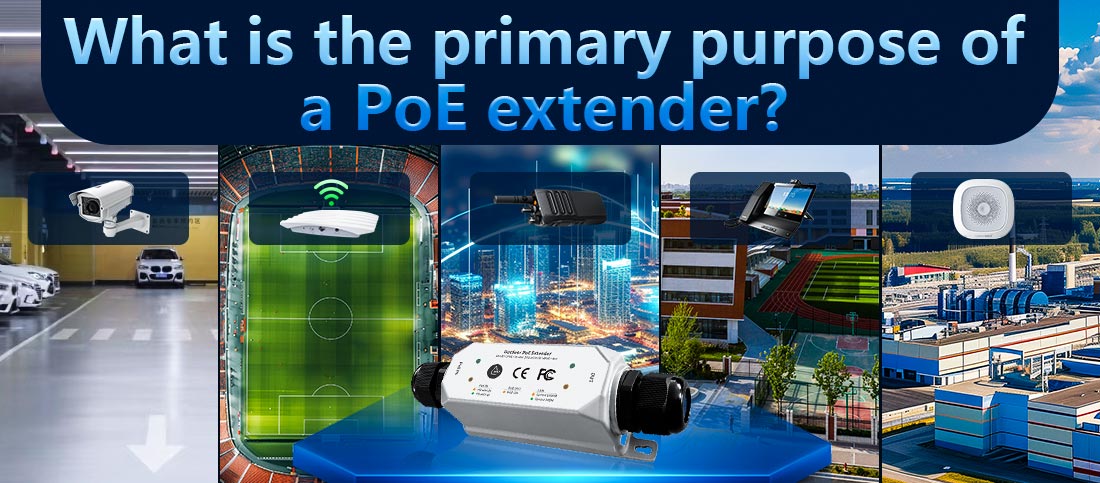
Objectif principal d'un prolongateur PoE
Un prolongateur Power over Ethernet (PoE) est un périphérique réseau conçu pour étendre la portée de la transmission d'alimentation et de données via des câbles Ethernet au-delà de la limite de distance standard de 100 mètres (328 pieds). Cela en fait un outil essentiel dans les scénarios où des appareils tels que des caméras IP, des points d'accès sans fil, des téléphones VoIP ou d'autres appareils compatibles PoE doivent être installés à des endroits plus éloignés du commutateur ou de l'injecteur réseau principal.
Fonctions clés d'un prolongateur PoE
1. Extension d'Ethernet et de la transmission d'énergie
--- Les câbles Ethernet ont une limitation naturelle de 100 mètres en raison de la dégradation du signal. Extensions PoE surmontez cette limitation en régénérant et en augmentant à la fois le signal de données et l'alimentation, permettant ainsi aux appareils d'être situés plus loin sans infrastructure supplémentaire.
2. Répéteur d'alimentation et de données
--- Un prolongateur PoE agit comme un répéteur, régénérant le signal de données pour garantir que la communication reste fiable et intacte sur la distance étendue. Dans le même temps, il redistribue l'alimentation de la source PoE pour garantir le bon fonctionnement des appareils connectés.
3. Solution rentable
--- Au lieu d'installer des câbles d'alimentation supplémentaires ou d'installer de nouveaux commutateurs réseau, un prolongateur PoE permet d'utiliser l'infrastructure Ethernet existante, économisant ainsi du temps et des coûts d'installation.
Applications des prolongateurs PoE
1. Systèmes de surveillance
--- Les extensions PoE sont couramment utilisées pour connecter des caméras IP situées dans des zones éloignées telles que des parkings, de grands entrepôts ou des périmètres d'une propriété où la distance dépasse la limite de 100 mètres.
2. Points d'accès sans fil
--- Dans les grands bâtiments ou les environnements extérieurs comme les campus ou les stades, les prolongateurs PoE permettent d'installer des points d'accès sans fil plus loin des hubs réseau pour fournir une couverture Wi-Fi plus large.
3. Systèmes de bâtiments intelligents
--- Les appareils tels que les capteurs, interphones et panneaux de contrôle compatibles PoE nécessitent souvent une installation à des distances étendues dans les bâtiments intelligents modernes. Les extensions PoE permettent cela sans sources d'alimentation supplémentaires.
4. Téléphonie VoIP
--- Les téléphones VoIP situés dans de grands immeubles de bureaux ou dans des environnements de campus peuvent être connectés à l'aide d'extenseurs PoE lorsqu'ils doivent être installés loin d'un commutateur.
5. Applications industrielles
--- Dans les usines ou les sites industriels, les extensions PoE permettent de déployer des capteurs, des contrôleurs ou d'autres appareils PoE dans des endroits difficiles d'accès.
Caractéristiques d'un prolongateur PoE typique
1. Extension de portée
--- Un seul prolongateur PoE ajoute généralement 100 mètres supplémentaires de portée. Plusieurs rallonges peuvent être mises en cascade pour atteindre des distances encore plus grandes, souvent jusqu'à 300 mètres ou plus, selon le modèle.
2. Installation prête à l'emploi
--- La plupart des extensions PoE sont simples à installer et ne nécessitent aucune configuration supplémentaire. Ils reçoivent l'énergie et les données de la source PoE et les transmettent à l'appareil connecté.
3. Conception compacte
--- Les extensions PoE sont généralement compactes, ce qui leur permet d'être facilement installées dans des espaces restreints ou montées discrètement sur les murs ou les plafonds.
4. Efficacité énergétique
--- De nombreux prolongateurs disposent d'une gestion efficace de l'énergie, garantissant une perte de puissance minimale tout en redistribuant l'énergie aux appareils en aval.
5. Compatibilité
--- Les extensions PoE prennent en charge les protocoles PoE standard tels que IEEE 802.3af (PoE), IEEE 802.3at (PoE+), et certains modèles avancés prennent en charge IEEE 802.3bt (PoE++) pour les applications de forte puissance.
6. Robustesse environnementale
--- Des extensions PoE de qualité industrielle sont disponibles pour les environnements extérieurs ou difficiles, avec des boîtiers résistants aux intempéries, de larges plages de températures de fonctionnement et une protection contre les surtensions.
Avantages de l'utilisation d'extendeurs PoE
1. Évolutivité
--- Ils permettent aux installations réseau d'évoluer facilement sans nécessiter de modifications majeures de l'infrastructure.
2. Flexibilité
--- Les appareils peuvent être placés dans des emplacements optimaux sans se soucier de la disponibilité de l'énergie ou des limitations de distance.
3. Rentable
--- Les extensions éliminent le besoin de prises de courant, de commutateurs ou de répéteurs supplémentaires, réduisant ainsi les coûts globaux.
4. Connectivité fiable
--- Grâce à la régénération avancée du signal et à la distribution d'énergie, les prolongateurs garantissent des performances constantes pour les appareils connectés.
5. Efficacité énergétique
--- Les extensions PoE utilisent l'énergie efficacement, consommant souvent uniquement l'énergie nécessaire pour prendre en charge les appareils en aval.
Limites des prolongateurs PoE
1. Bilan de puissance
--- La puissance totale disponible diminue avec chaque prolongateur en raison des pertes dans le câble et le prolongateur lui-même. Une budgétisation minutieuse de l’énergie est nécessaire, en particulier lors de l’utilisation d’appareils à haute puissance.
2. Bande passante des données
--- Le répéteur n'augmente pas la bande passante du réseau et l'utilisation de plusieurs répéteurs peut entraîner une légère latence, en particulier dans les applications gourmandes en données.
3. Contraintes de distance
--- Même si plusieurs prolongateurs peuvent étendre la portée, il existe une limite pratique basée sur la perte de puissance et l'intégrité du signal.
Conclusion
L'objectif principal d'un prolongateur PoE est de permettre le déploiement d'appareils compatibles PoE au-delà de la limite de distance standard du câble Ethernet de 100 mètres. En augmentant les signaux d'alimentation et de données, les prolongateurs PoE permettent de créer des installations réseau flexibles, évolutives et rentables. Ils sont largement utilisés dans la surveillance, les réseaux sans fil, l'automatisation industrielle et les systèmes de bâtiments intelligents, offrant une solution fiable pour étendre l'alimentation et la connectivité aux appareils distants.